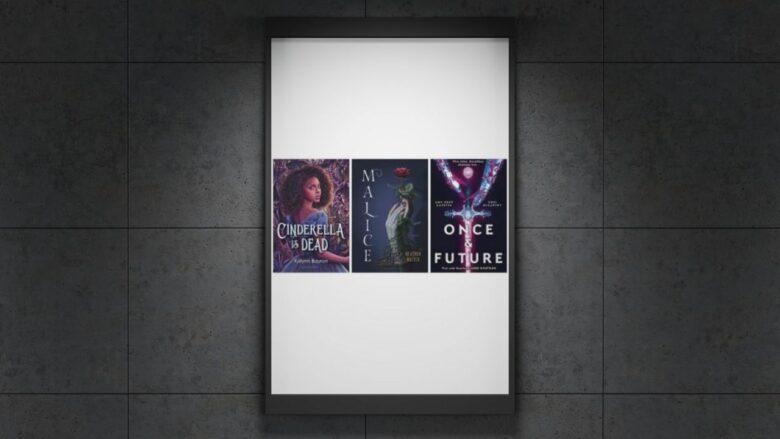Fairy tales have long shaped the foundations of fantasy storytelling, passed down through generations in familiar patterns: a damsel in distress, a valiant prince, a wicked stepmother, and the inevitable triumph of heteronormative “true love.” These narratives, while iconic, often reflect rigid social norms—particularly around gender roles, sexuality, and moral binaries.
But fantasy has always had the potential to reimagine what’s possible. In recent years, LGBTQIA+ authors have been breathing new life into classic fairy tale frameworks, using them not to reinforce tradition, but to challenge it. Through bold retellings and original reimaginings, these authors are reclaiming space in the genre, reshaping who gets to be the hero, what a happy ending looks like, and whose love stories get told.
This guide explores a curated selection of LGBTQIA+ fantasy novels that turn familiar tropes on their heads. Whether by queering iconic roles, centering characters that defy gender expectations, or upending the narrative arcs we’ve come to expect, each book offers a powerful alternative to the traditional fairy tale mold.
Expect to find richly imaginative worlds, compelling queer characters, and stories that don’t just update old tales—they transform them.
Why Fairy Tale Subversion Matters in LGBTQIA+ Fantasy
Fairy tales are some of the first stories many of us encounter. Their imagery, morals, and characters shape our understanding of love, identity, and what it means to live “happily ever after.” But for LGBTQIA+ readers and creators, these stories have often felt exclusionary—offering little to no space for queer experiences, and reinforcing heteronormative and binary ideals.
Subverting these tales is more than just a creative twist—it’s a powerful act of reclamation.
Representation in Familiar Storytelling Frameworks
When LGBTQIA+ characters step into the roles of heroes, lovers, and villains in reimagined fairy tales, they become visible in a genre that historically erased them. These stories don’t require readers to abandon the magic and wonder of fairy tales; instead, they allow readers to see themselves within that magic. For many, that recognition in a beloved narrative form is both affirming and transformative.
Challenging Normative Narratives
Traditional fairy tales often promote narrow definitions of love (usually heterosexual), gender roles (princesses need saving; princes must be brave), and morality (good vs. evil with little nuance). LGBTQIA+ retellings challenge these conventions. They explore fluid gender identities, non-traditional relationships, complex characters who defy moral binaries, and the idea that love and happiness come in many forms. These stories resist the notion that queerness must exist outside the realm of fantasy—or that queerness is inherently tragic.
Imagining Inclusive Futures and Reclaiming Myth
Fantasy, at its core, is about imagining worlds that are different from our own. It gives writers and readers permission to envision possibilities beyond societal constraints. Queer fairy tale retellings don’t just revise old stories—they propose new cultural myths that center inclusivity, agency, and diverse forms of love and identity. In doing so, they help to heal historical exclusions while building bridges to a more inclusive literary future.
Through subversion, LGBTQIA+ fantasy doesn’t just rewrite stories—it rewrites the rules of who stories are for.
Standout LGBTQIA+ Fantasy Novels That Subvert Fairy Tale Tropes
These novels don’t just reimagine fairy tales—they challenge the very foundations of their most iconic tropes. From villain origin stories to epic fantasies free from patriarchal structures, each of the following titles offers a fresh, inclusive perspective on what fantasy can be.
Malice by Heather Walter
Synopsis: In this dark retelling of Sleeping Beauty, the story is told from the perspective of Alyce, a young woman feared for her dark magical lineage. Rather than the evil sorceress archetype, Alyce is a misunderstood outcast who falls in love with the very princess she was destined to curse.
Tropes Subverted:
- The “evil sorceress”
- “True love’s kiss” as a heterosexual, moral resolution
- Villain vs. hero binary
Why It Stands Out: Malice reclaims the villain’s story and turns it into a powerful romance between two women. It invites readers to question the roots of villainy, how history is written, and whether “happily ever after” is always what it seems.
The Priory of the Orange Tree by Samantha Shannon
Synopsis: This sweeping epic blends dragon mythology with courtly intrigue across multiple kingdoms, each with its own cultural structure. At its heart are powerful women—rulers, warriors, and scholars—and central queer relationships that drive the story.
Tropes Subverted:
- Damsels in distress
- Male-dominated monarchies
- Love as a subplot secondary to war or conquest
Why It Stands Out: Shannon’s world is vast, inclusive, and unapologetically matriarchal. Queer love isn’t a side note—it’s a vital part of the characters’ journeys. The book elevates female and queer voices in an epic traditionally dominated by men.
Cinderella Is Dead by Kalynn Bayron
Synopsis: Set generations after Cinderella found her prince, the kingdom now enforces an annual ball where girls are chosen by suitors—or face punishment. Sixteen-year-old Sophia, who loves women, defies the system and uncovers the truth behind the myth.
Tropes Subverted:
- “Chosen girl” narrative
- Prince saves the day
- Happily ever after through marriage
Why It Stands Out: This novel interrogates the legacy of fairy tales and how they can be twisted into tools of oppression. Sophia’s resistance is both political and personal, offering a fierce critique of tradition while reclaiming agency and queerness.
In the Watchful City by S. Qiouyi Lu
Synopsis: In the city of Ora, the protagonist Anima watches over its citizens through a neural network, balancing order and identity. When a mysterious visitor arrives with stories from beyond the city, Anima begins to question everything.
Tropes Subverted:
- Linear hero’s journey
- Gender as a fixed binary
- Power as control rather than connection
Why It Stands Out: Though not a direct fairy tale retelling, In the Watchful City uses a fable-like structure and poetic prose to challenge conventions of storytelling itself. With a nonbinary protagonist and a narrative that prioritizes transformation over resolution, it offers a truly unique reading experience.
Girls Made of Snow and Glass by Melissa Bashardoust
Synopsis: A feminist retelling of Snow White, this novel alternates between Mina, the stepmother, and Lynet, the princess created from snow. Both wrestle with expectations of beauty, power, and what it means to love.
Tropes Subverted:
- Evil stepmother
- Beauty as virtue
- The passive princess
Why It Stands Out: By humanizing both the “villain” and the “princess,” Bashardoust crafts a nuanced, emotionally rich story that centers the relationship between women rather than rivalry. The subtle queer elements and emphasis on self-discovery make this a powerful subversion of the original tale.
Each of these novels not only reimagines fairy tales but also expands the fantasy genre’s capacity for inclusivity, depth, and emotional resonance. In the next section, we’ll look at even more titles that deserve a place on your TBR.
Other Notable Mentions
Beyond the standout titles already highlighted, several other LGBTQIA+ fantasy novels offer imaginative and subversive takes on fairy tale tropes. Each of the following books contributes uniquely to the ongoing transformation of traditional narratives.
Ash by Malinda Lo
A quiet and lyrical retelling of Cinderella with a sapphic romance at its core. Instead of the traditional prince, Ash finds love and freedom through a relationship with the King’s Huntress.
Tropes Subverted:
- Prince as the only romantic option
- Love as rescue
- Heteronormative “happy ending”
The Mermaid, the Witch, and the Sea by Maggie Tokuda-Hall
A high-seas adventure featuring genderfluid and queer protagonists, mermaids, and empire-driven conflict. The book intertwines fantasy with themes of colonialism, identity, and liberation.
Tropes Subverted:
- Fixed gender roles
- Passive mermaid mythology
- Love as secondary to heroism
Peter Darling by Austin Chant
A trans retelling of Peter Pan, this novel imagines Peter as a young trans man who returns to Neverland and faces both external conflict and internal reckoning.
Tropes Subverted:
- Eternal boyhood as escapism
- Gender rigidity
- The romanticized “child hero”
Thorn by Intisar Khanani
A reimagining of the Brothers Grimm tale The Goose Girl, this story centers a quiet, determined princess who resists political manipulation through inner strength and integrity, with underlying queer themes.
Tropes Subverted:
- Docile princess archetype
- Heroism through violence or force
- Marriage as the reward for virtue
Silver in the Wood by Emily Tesh
Inspired by green man folklore, this novella features a m/m romance between a forest guardian and a curious folklorist. It’s a tender, mythic exploration of love, transformation, and healing.
Tropes Subverted:
- Male protagonists as emotionally distant
- Nature as backdrop rather than character
- Romantic fulfillment tied to conquest
These notable mentions continue to show how fairy tale tropes can be expanded, deconstructed, and rebuilt through an LGBTQIA+ lens—proving that the genre is richer, queerer, and more imaginative than ever.
Tips for Readers Looking for More Queer Fairy Tale Retellings
The world of queer fantasy and fairy tale subversions is vast and growing. If you’re eager to explore beyond the titles listed here, these practical tips will help you discover more inclusive, imaginative stories that challenge traditional narratives and center LGBTQIA+ experiences.
Follow Queer Indie Publishers and Authors
Many of the most innovative queer retellings come from independent presses and self-published authors who have greater freedom to push genre boundaries. Look out for publishers like Luna Press, NineStar Press, Bywater Books, and Neon Hemlock. Following authors on social media or through newsletters can also alert you to new releases, Kickstarter campaigns, and exclusive content.
Explore Fanfic Communities for Transformative Takes
Fanfiction has long been a space for queer readers and writers to reinterpret mainstream stories through a more inclusive lens. Platforms like Archive of Our Own (AO3) and Tumblr are treasure troves of fairy tale-inspired stories with queer protagonists. These communities are often at the forefront of narrative experimentation and representation, and many published authors got their start here.
Use LGBTQIA+ Book Tags on Goodreads and StoryGraph
Search by tags such as LGBTQIA+ retelling, queer fantasy, fairy tale retelling, or sapphic/m/m romance in fantasy to uncover reader-curated lists and recommendations. StoryGraph is especially useful for personalized searches based on mood, pacing, and content themes. These tools can help you find books that match your specific interests—whether that’s a dark sapphic twist on Beauty and the Beast or a whimsical gender-bent Red Riding Hood.
Look for Anthologies and Short Story Collections
Collections like The Book of Dragons (edited by Jonathan Strahan) or Queer Tales of the High Seas often feature reimagined myths and fairy tales with queer characters. Anthologies are a great way to sample diverse voices and styles—and they often include hidden gems by up-and-coming queer authors you might not encounter otherwise.
By being intentional in your search and open to both traditional and nontraditional sources, you’ll find that queer fairy tale retellings are everywhere—bold, beautiful, and ready to rewrite the stories we thought we knew.
Conclusion
At its core, storytelling is about possibility—about imagining worlds that could be, rather than simply reflecting the world that is. LGBTQIA+ fantasy novels that subvert fairy tale tropes do more than reimagine familiar tales; they reclaim narrative space, challenge outdated norms, and offer bold new visions of identity, love, and power.
By queering these classic frameworks, authors are not only reshaping the stories themselves but also the cultural expectations they carry. They’re making space for readers who have long been pushed to the margins and proving that magic, heroism, and happily-ever-afters belong to everyone.
Whether you’re new to queer fantasy or already deep into the genre, the novels and authors highlighted in this guide are only the beginning. Each story offers a chance to see the familiar transformed—and to support the creators who are bravely reshaping the literary landscape.
So crack open a book, step into a world that dares to be different, and let yourself be enchanted by stories that reflect the full spectrum of who we are.





Comments
Very good https://lc.cx/xjXBQT